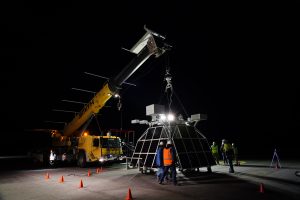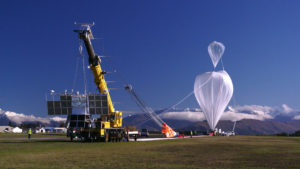The window for NASA’s super pressure balloon (SPB) launch from Wanaka Airport, New Zealand, opened Monday, May 9 (Tuesday, May 10 in New Zealand) for a mission that will take the 2.5-ton, football-stadium-sized balloon on a long-duration test flight.
At this time, NASA is planning a launch attempt for Tuesday, May 10 (Wednesday, May 11 in New Zealand)— the planned time for this launch attempt is 10 a.m. local New Zealand standard time (NZST).
“Our team has done an amazing job overcoming some massive logistical challenges and performing a number of check-outs on the balloon, gondola, and support instruments to get us to this point now where we’re ready for launch,” said Debbie Fairbrother, NASA’s Balloon Program Office chief. “From here, we just need Mother Nature to cooperate with the launch weather requirements we have to both ensure safety and mission success—I’m looking forward to this first launch attempt.”
For launch, winds need to be light and flowing in a reliable direction both at the surface and at low levels up to about 1,000 feet (300 meters). Winds flowing in opposite directions on the ground and lower levels could have a shearing effect on the balloon. In addition, NASA monitors for favorable stratospheric wind conditions at 110,000 feet (33.5 km), which is where the balloon will float.
For subsequent launch attempts, if needed, NASA will announce by 2 p.m. NZST (10 p.m. ET) if the next day’s forecast weather will support a launch attempt.
The launch can be tracked in the following ways:
- A live feed of the launch is available here: http://www.ustream.tv/channel/nasa-csbf-downrange-operations
- Track the progress of the flight at the following link, which includes a map showing the balloon’s real-time location, at: http://www.csbf.nasa.gov/newzealand/wanaka.htm

After launch the 18.8-million-cubic-foot (532,000 cubic-meter) SPB will ascend to its float altitude where the stratospheric winds will propel it at speeds up to and exceeding 100 knots on a weeks-long journey around the southern hemisphere.
The primary goal of the flight is to validate and certify the SPB technology, and in particular, the balloon’s capability to pressurize at high altitudes. This ability to pressurize and maintain a consistent, pumpkin-like shape enables the balloon to float at a constant density altitude despite the heating and cooling of the day-night cycle. Without this pressurization, the helium gas inside the balloon would expand and contract through the day-night cycle, causing changes in buoyancy that ultimately lead to changes in altitude.
The science and engineering communities have previously identified long-duration balloon flights at constant altitudes as playing an important role in providing inexpensive access to the near-space environment for science and technology. NASA’s SPB flights from the southern hemisphere keep the balloon primarily over water and open airspace, which is key for achieving long-duration flight times upward of 100 days.
This launch is the fourth test launch from Wanaka Airport since NASA began balloon flight operations there in 2015.

NASA conducts SPB launches from New Zealand in collaboration with the Queenstown Airport Corporation, Queenstown Lake District Council, and Airways New Zealand. After this year’s flight, the team plans to return to Wanaka in 2023 for two super pressure balloon flights, each with its own dedicated science mission of opportunity.
NASA’s Wallops Flight Facility in Virginia manages the agency’s scientific balloon flight program with 10 to 15 flights each year from launch sites worldwide. Peraton, which operates NASA’s Columbia Scientific Balloon Facility (CSBF) in Texas, provides mission planning, engineering services, and field operations for NASA’s scientific balloon program. The CSBF team has launched more than 1,700 scientific balloons over some 40 years of operations.
For more information about NASA’s scientific balloon program, see: https://www.nasa.gov/scientificballoons.
